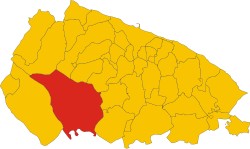
Back Altamura AN ألتامورا Arabic التامورا ARZ Altamura AVK Altamura Azerbaijani آلتامورا AZB Алтамура Bulgarian Altamura Breton Altamura Catalan Альтамура CE
Altamura
Ialtamùre (Neapolitan) | |
|---|---|
| Comune di Altamura | |
 | |
 Altamura within the Province of Bari | |
| Coordinates: 40°49′N 16°33′E / 40.817°N 16.550°E | |
| Country | Italy |
| Region | Apulia |
| Metropolitan city | Bari (BA) |
| Frazioni | Casal Sabini, Fornello, Madonna del Buon Cammino, Marinella, Masseria Franchini, Pescariello, Sanuca |
| Government | |
| • Mayor | Francesco Rinaldi |
| Area | |
| • Total | 427 km2 (165 sq mi) |
| Elevation | 450 m (1,480 ft) |
| Population (31 July 2017)[2] | |
| • Total | 70,539 |
| • Density | 170/km2 (430/sq mi) |
| Demonym | Altamuran |
| Time zone | UTC+1 (CET) |
| • Summer (DST) | UTC+2 (CEST) |
| Postal code | 70022 |
| Dialing code | 080 |
| Patron saint | Saint Irene of Lecce |
| Saint day | May 5 |
| Website | Official website |



Altamura (/ˌæltəˈmʊərə/; Italian: [ˌaltaˈmuːra]; Barese: Ialtamùre) is a town and comune of Apulia, in southern Italy. It is located on one of the hills of the Murge plateau in the Metropolitan City of Bari, 45 kilometres (28 miles) southwest of Bari, close to the border with Basilicata. As of 2017[update], its population amounts to 70,595 inhabitants.[3]
The city is known for its particular quality of bread called Pane di Altamura, which is sold in numerous other Italian cities. The 130,000-year-old calcified Altamura Man was discovered in 1993 in the nearby limestone cave called grotta di Lamalunga.

- ^ "Superficie di Comuni Province e Regioni italiane al 9 ottobre 2011". Italian National Institute of Statistics. Retrieved 16 March 2019.
- ^ "Population data from ISTAT - National Institute of Statistics (Italy)".
- ^ (in Italian) Source: Archived 2014-02-02 at the Wayback Machine Comune di Altamura 12-31-2013
- ^ pupillo-immaini, pag. 19



